Neuschwanstein Castle, located in southwest Bavaria, Germany, stands as a testament to the romantic imagination of King Ludwig II. Commissioned in 1868 and designed by scene painter Christian Jank under Ludwig’s visionary guidance, the castle embodies the Romanesque Revival architectural style. This 19th-century palace near Hohenschwangau and Füssen is a grand homage to medieval knighthood, chivalry, and the operatic works of Ludwig’s friend, Richard Wagner. The castle envisioned over 200 rooms, but only 15 were completed before Ludwig died in 1886. The castle’s exterior is characterized by white limestone, towering spires, turrets, and arched windows, all reminiscent of medieval castles. Neuschwanstein Castle’s influence on German architecture is profound. It sparked a revival of Romanesque Revival architecture, inspiring churches, city halls, and universities. The primary purpose of Neuschwanstein Castle was to serve as Ludwig’s retreat and homage to medieval German culture. Its design, featuring an imaginative mix of medieval elements and modern amenities, catered to Ludwig’s desire for an idealized medieval castle. Maintenance of Neuschwanstein Castle is an ongoing challenge due to its delicate materials and high visitor volume. Neuschwanstein Castle is embedded in the cultural and historical context of 19th-century Bavaria and Europe. The integration of modern technology within its historic appearance speaks to the 19th-century outlook of progress and industrial innovation. The ongoing restoration faces challenges in preserving delicate interior artworks, stabilizing the structure against weathering, and managing the impact of tourism while maintaining authenticity. Neuschwanstein Castle offers valuable lessons. It emphasizes the importance of balancing client wishes, functionality, and context in design. The restoration challenges underscore the need for architects to consider long-term maintenance impacts and durability in ornate buildings. In Germany, Neuschwanstein Castle is not alone in architectural significance. The Bauhaus sites in Dessau and Weimar provide insights into early 20th-century modernist design. Post-reunification Berlin showcases a diverse range of 20th-century architectural styles, while Ludwig II’s other palaces, Linderhof and Herrenchiemsee.
What is the Neuschwanstein Castle?
Neuschwanstein Castle is a 19th-century palace in southwest Bavaria, Germany, near Hohenschwangau and Füssen. King Ludwig II of Bavaria commissioned the construction of Neuschwanstein Castle. It was designed in 1868 by set designer Christian Jank and then realized by architect Eduard Riedel. Though over 200 rooms had been planned initially, only about 15 were finished when Ludwig died in 1886 without ever seeing its completion. The castle’s white limestone façade and peaked towers were inspired by medieval castles, especially the Wartburg in Eisenach. Its Romanesque architecture features grand spires, turrets, vaulted ceilings, and Byzantine-style elements. The Throne Room is modeled on a church nave and decorated with frescoes depicting angels. Interiors also showcase themes from Wagnerian operas and Germanic myths that captivated Ludwig’s imagination. Designed by scene painter Christian Jank and architects Eduard Riedel, Georg von Dollmann, and Julius Hofmann, Neuschwanstein Castle features white limestone towers, turrets, spires, and Romanesque arches echoing a fanciful medieval castle. The castle boasted modern amenities like running water, heating, and telephones. Despite being built in the late 1800s, the palace integrated modern technologies like running water, central heating, telephones, and electric bells to summon servants. Neuschwanstein Castle opened as a museum just seven weeks after his 1886 death and remains one of Germany’s most popular tourist attractions.
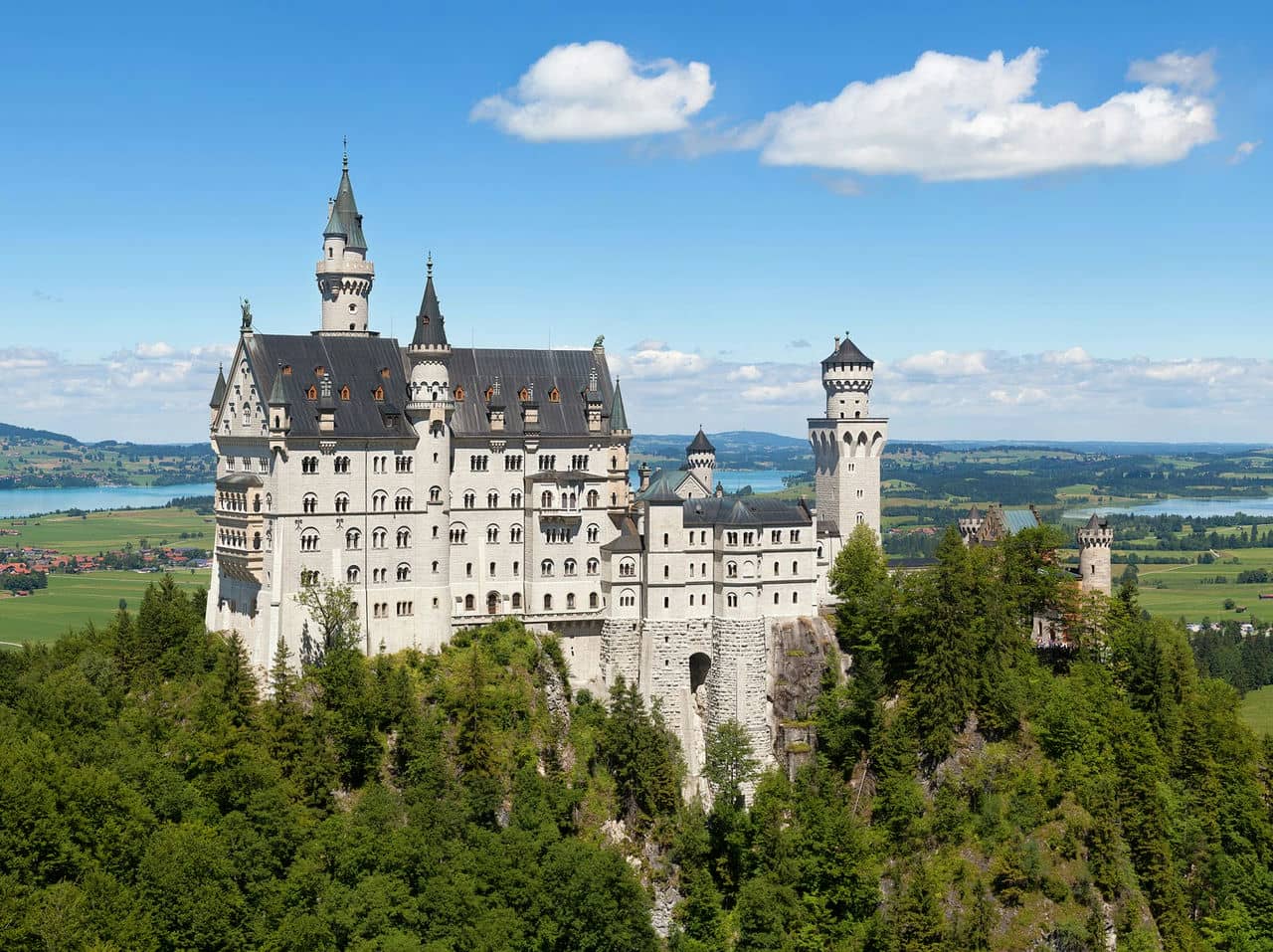
What architectural style is most prominent in the Neuschwanstein Castle?
Neuschwanstein Castle is most prominently designed in the Romanesque Revival architectural style. The castle envisioned the castle as a romantic homage to the culture and ideals of medieval knighthood and chivalry. Ludwig II hired set designer Christian Jank to make dramatic conceptual drawings of the castle to bring this vision to life. These drawings were then translated into architectural plans by Eduard Riedel. Romanesque architecture was typical in medieval Europe between the 10th and 12th centuries. Semi-circular arches, vaulted ceilings, thick walls, towers, and decorative arcading characterize it. Neuschwanstein revives and romanticizes these medieval Romanesque elements on a grand, idealized scale. The exterior of Neuschwanstein is dominated by white limestone and red brick construction accented by tall multi-story towers, turrets, spires, and arched windows. The Throne Room exemplifies the Romanesque style with its Byzantine-inspired painted cupola ceiling and decorative arched colonnades. Other interiors feature vaulted corridors, arched doorways, fresco wall paintings, and wood carvings reminiscent of medieval craftsmanship. It also incorporated 19th-century building technologies like steel framing and featured modern conveniences like electric lighting, flush toilets, hot running water, and central heating. This allowed Ludwig to realize his vision of the perfect medieval castle updated to his era’s comfort standards.
What structural engineering principles were employed in the construction of the Neuschwanstein Castle?
The construction of Neuschwanstein Castle employed several innovative structural engineering principles. Firstly, the castle was built using a steel framework for the walls and floors rather than solely using traditional masonry. This steel framework reinforced the structure and allowed larger open interior spaces than typical medieval castle construction. Secondly, the natural terrain and hillside location were incorporated into the structural design. Retaining walls structurally stabilized the terraces carved out of the hill. Thirdly, new water supply systems using iron pipes and valves allowed running water to be distributed throughout the castle, including flushing toilets. Drains and sewers were built into the structure, utilizing slopes and gravity to carry waste away. Lastly, modern plumbing and HVAC systems were integrated into the building’s structural framing during construction. Neuschwanstein Castle combined medieval architecture and aesthetics with current structural design approaches, including a steel framework, terraced foundations tailoring the site terrain, and integrated plumbing and heating systems.
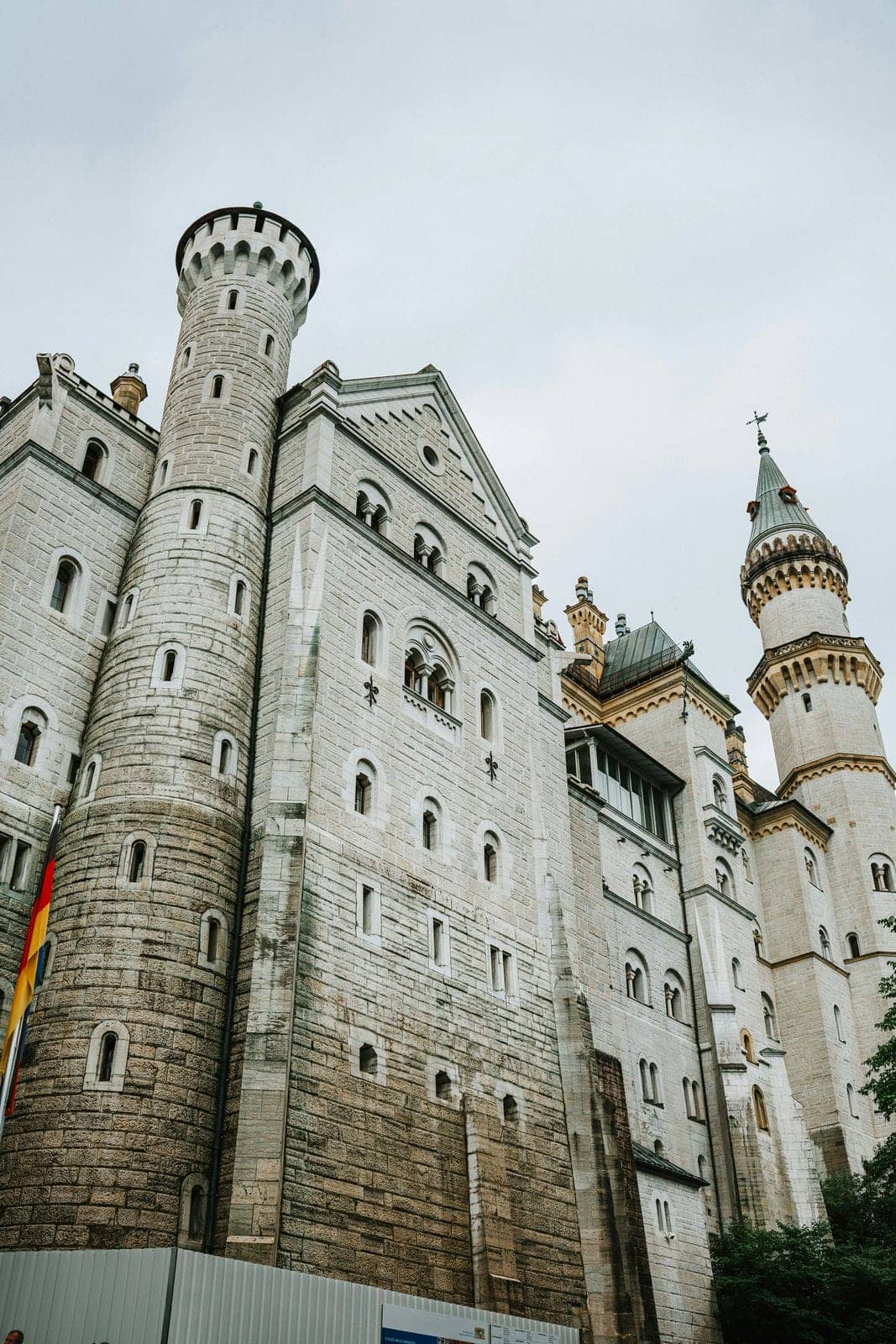
Who designed the Neuschwanstein Castle?
The Neuschwanstein Castle was designed primarily by scene painter Christian Jank under the vision and direction of King Ludwig II of Bavaria. King Ludwig II commissioned the Neuschwanstein Castle in 1869, intending for it to be a retreat and tribute to medieval culture and the operas of his friend Richard Wagner. To bring his vision to life in the form of conceptual drawings, Ludwig II hired Christian Jank, a scene painter and set designer from the Munich Court Opera House. Jank had expertise in creating vivid theatrical backdrops and settings. His paintings and designs captured the dramatic, romanticized medieval vision Ludwig wished the castle to embody. Jank drew inspiration from various sources, including Germanic legends, Wagnerian mythology, and Wartburg Castle’s historical architecture. The theatrical nature of Jank’s drawings and paintings established Neuschwanstein’s fairytale aesthetic inside and out. His exterior designs focused on towers, turrets, arched windows, and white walls accented by red bricks. Jank’s conceptual paintings were then translated into technical architectural plans by Eduard Riedel to enable actual construction. Later architects such as Georg Dollman and Julius Hofmann built upon Jank and Riedel’s original designs as work progressed.
What are the historical design influences visible in the Neuschwanstein Castle?
The design of Neuschwanstein Castle draws influences from multiple historical sources. Firstly, Neuschwanstein revives and romanticizes Romanesque architectural elements on a grand scale. Romanesque architecture flourished in medieval Europe between the 10th and 12th centuries and is defined by rounded arches, vaulted ceilings, towers, and decorative arcades. These details are abundantly visible on Neuschwanstein’s exterior limestone façade and interior spaces like the Throne Room. Secondly, Neuschwanstein embodies the 19th-century architectural approach of historicism, which sought to revive historical styles and “perfect” them with modern technologies. King Ludwig II wished to recreate a medieval castle updated to his era’s comforts. Thirdly, the actual design of Neuschwanstein was directly inspired by a specific medieval castle – Wartburg Castle. The Palas building of Wartburg provided a model for Neuschwanstein’s Singers’ Hall and other interiors. The wall paintings in Wartburg’s halls also inspired the frescoed walls of Neuschwanstein, depicting legends and operas. Neuschwanstein Castle predominantly reflects a Romanesque Revival architectural style romanticizing medieval castles.
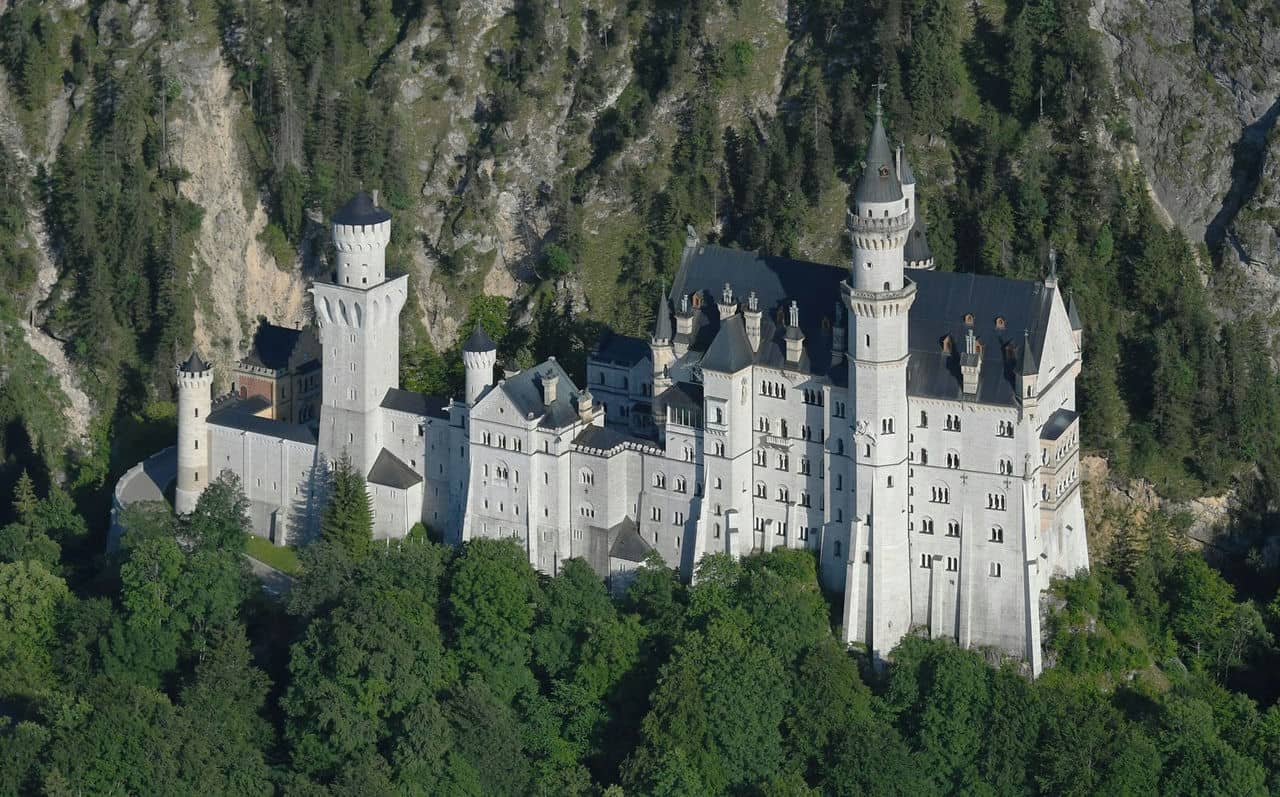
How has the Neuschwanstein Castle influenced the design of other buildings in Germany?
Neuschwanstein Castle has influenced the design of other buildings in Germany in a few key ways. Firstly, it revived and popularized Romanesque Revival architecture, a popular style for churches, city halls, universities, and other public buildings in the late 19th and early 20th centuries. Neuschwanstein romanticized Romanesque features like rounded arches, towers, arcades, vaulted ceilings, and ornate decorative details. German buildings emulated this style as it embodied a romantic medieval. Secondly, it established the fairytale castle as an iconic form of German architecture. This inspired many other mock medieval castles, palaces, and grand hotels built in rural German regions to tap into this imagery. These buildings replicated Neuschwanstein’s turreted skyline and picturesque hilltop setting. Lastly, Neuschwanstein demonstrated how historicist architecture could integrate modern technology and comfort. Reviving a medieval Romanesque style, Neuschwanstein Castle had modern amenities like electric lighting, flush toilets, central heating, etc.
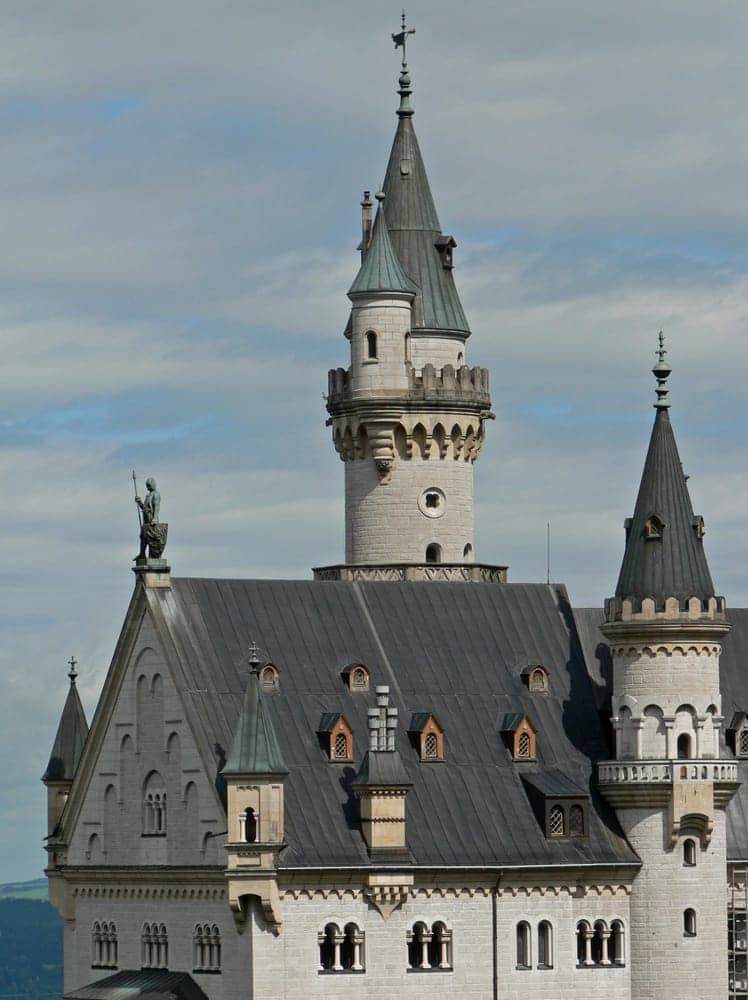
What purpose does the Neuschwanstein Castle serve, and how does the design help?
Neuschwanstein Castle serves primarily as a personal refuge and tribute to the German medieval past and the operas of Richard Wagner. Rather than a defensive fortress or seat of government, it was Ludwig’s private fantasy world brought to life. The castle’s design and decoration reflect this purpose. While incorporating modern amenities like electric lighting and heating, the architecture mimics a medieval castle with soaring towers, turrets, high walls, and an ornate Gothic facade. However, there is no actual throne, indicating the palace was meant as an imaginative escape for Ludwig rather than an official royal residence. The isolated mountainous location looking out over Alpine lakes and forests also contributes to the atmosphere. Visitors today can still feel transported in time and space thanks to the carefully crafted environment. Neuschwanstein, as a personal refuge after his mysterious death and the abolition of the monarchy, was opened to the public. It serves the dual purpose of royal retreat and public monument to Ludwig’s imaginative reign. The beauty of the design and setting continue to inspire reveries in visitors just as they did for the Fairytale King. The design and location cater to this purpose, crafting an atmosphere where Ludwig could play out his operatic dreams in opulent solitude.
How is the Neuschwanstein Castle maintained?
Neuschwanstein Castle requires extensive ongoing maintenance due to its design, materials, and high volume of visitors. Firstly, Neuschwanstein features elaborate murals, textiles, woodcarvings, and other details as a palace built in the historicist style to realize King Ludwig II’s romantic medieval fantasies. However, many materials are fragile, especially under the strain of 1.4 million annual visitors. The Bavarian Palace Department has conducted gradual room-by-room restoration work on the artwork and interiors since 2017, with projects expected to continue through 2024. This involves carefully cleaning surfaces, performing repairs, and protecting vulnerable objects. Secondly, maintaining the exterior limestone façades and stonework. Neuschwanstein’s towers and ornamentation face weathering from the harsh alpine climate, including snow, ice, and thawing cycles. Sections of the walls require ongoing monitoring and stabilization to prevent cracks or collapse. Damaged stones must be replaced to keep them in their original appearance. Thirdly, continually upgrading access, facilities, and visitor flow. Logistics are a significant consideration as a top tourist destination working to accommodate massive crowds. The castle’s walkways and viewing platforms require periodic refurbishment to handle thousands of daily footfalls without wear.
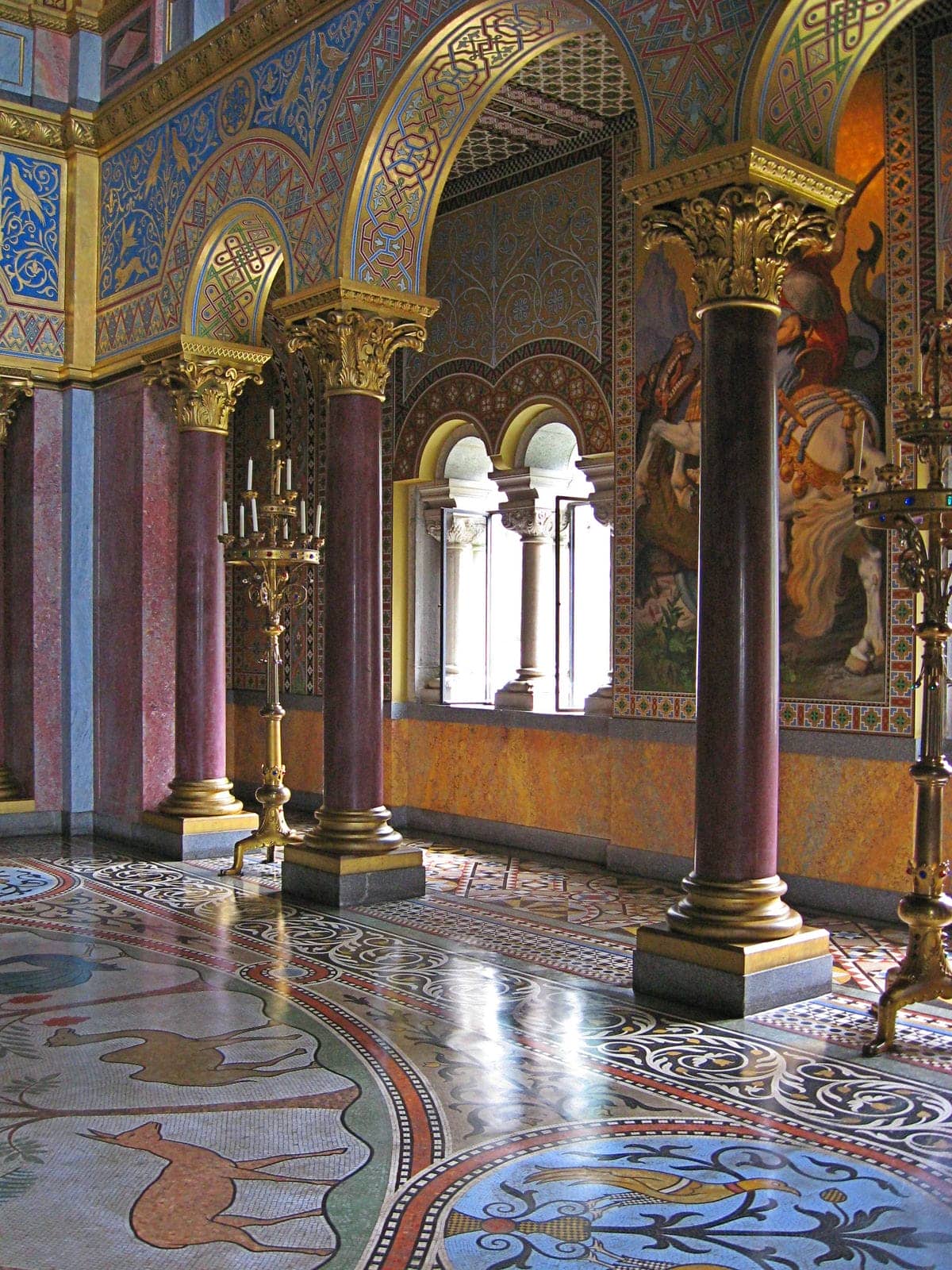
How does the Neuschwanstein Castle reflect cultural and contextual relevance in their design?
Neuschwanstein Castle’s design directly reflects the cultural ideals and historical context of 19th-century Bavaria and Europe in several key ways. Firstly, its medievalist style and decoration embodied the widespread Romantic fascination with the Middle Ages prevalent at the time. Secondly, the castle served as a symbolic refuge where Ludwig could retreat into his fantasies and imaginatively reclaim his sovereignty amidst political turmoil. Its secluded mountain setting and emphasis on private living spaces rather than grand halls for court functions reflected Ludwig’s withdrawal from public life after losing power in the wake of war. In this way, Neuschwanstein’s purpose and design were deeply tied to the collapse of old European monarchical structures in the 1800s. Thirdly, incorporating modern technology despite its historical appearance revealed the outlook of 19th-century historicism. Architects of the era believed that while reviving past styles, they could improve upon the originals via engineering advances and academic research. Neuschwanstein evoked a mythical medieval castle, the conveniences Ludwig included, from electricity to telephones to central heating, demonstrated contemporary values of progress and industrial innovation.
What architectural trend or movement does the Neuschwanstein Castle represent?
Neuschwanstein Castle represents the architectural style of historicism. The castle is a romantic historicist building commissioned by King Ludwig II of Bavaria in 1868. Located on a hilltop overlooking Alpine lakes and mountains, the castle’s design is inspired by medieval castles and incorporates features like tall multi-story towers, turrets, and battlements. The interiors reflect the historicist emphasis on medieval themes, with rooms decorated in ornate Byzantine and Romanesque styles, extensive murals depicting legends from Germanic mythology and Wagnerian operas, and a great hall inspired by the medieval Wartburg castle. Neuschwanstein also incorporates modern technology, boasting hot and cold running water, flush toilets, central heating, electric bells, and telephones. Its dramatic mountaintop setting reinforces its image as a fairy tale castle plucked from historicist imagination.
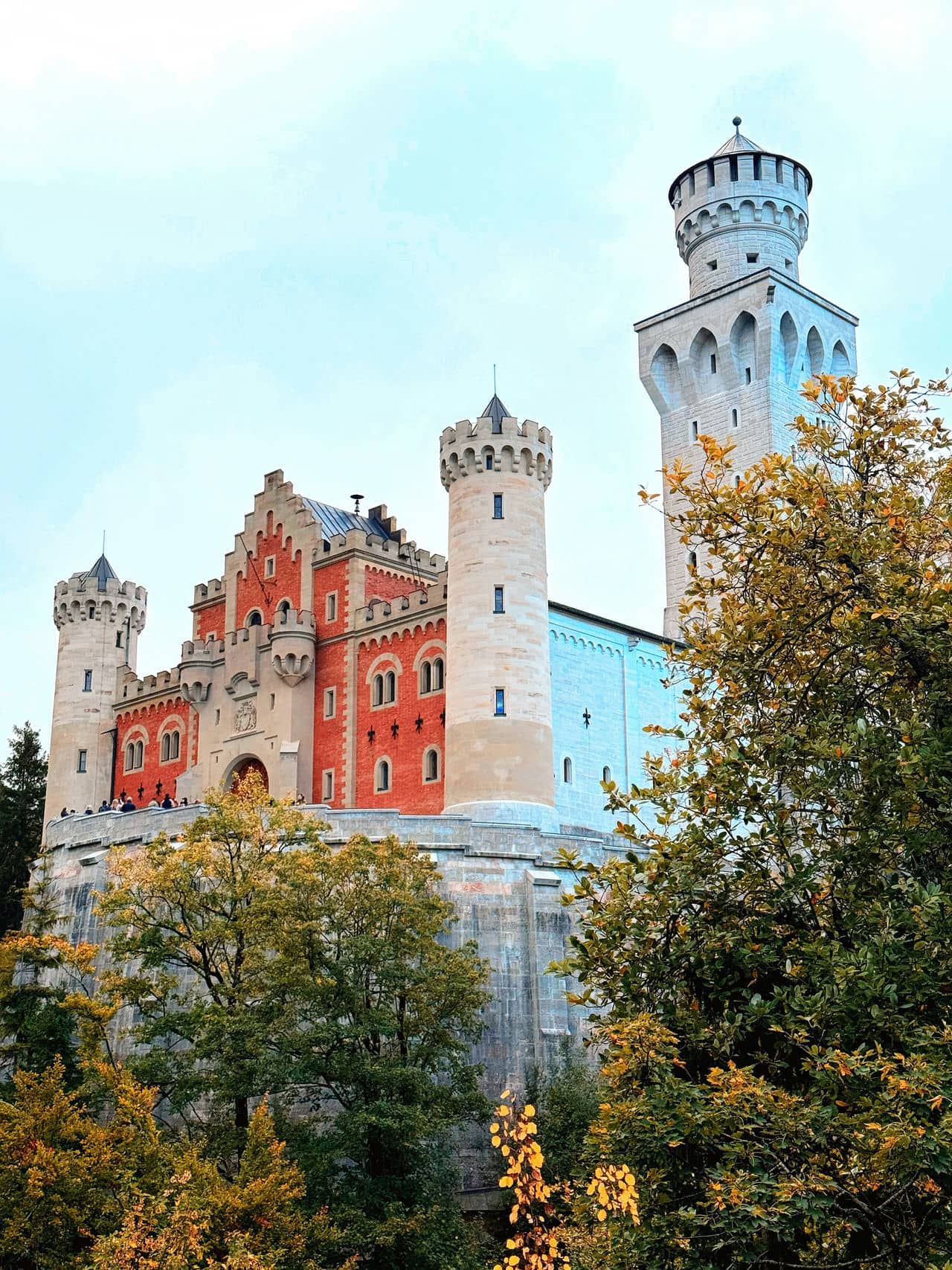
What are the challenges faced during the restoration of the Neuschwanstein Castle?
The ongoing restoration of Neuschwanstein Castle faces several key challenges. Firstly, preserving the fragile interior artworks and decorations under the strain of heavy tourism takes a lot of work. Neuschwanstein features intricate details like murals, textiles, woodcarvings, and paintwork. However, with over $1.4 million (€1.3 million, £1.1 million) annual visitors streaming through the rooms and staircases, these delicate surfaces and fabrics face gradual damage from vibration, humidity, dust, and simple wear and tear over time. The restoration teams must carefully clean, structurally reinforce, and protect the irreplaceable artworks from further deterioration. Secondly, securing and stabilizing the structure against weathering and erosion requires extensive masonry repairs. Neuschwanstein’s towers and ornamented limestone facades are exposed to dramatic seasonal shifts from Bavaria’s cold, snowy winters to warmer summers. Repeated freeze-thaw cycles have opened cracks and destabilized sections of the walls. Restorers must monitor for new damage and faults, replacing damaged stones and reinforcing vulnerable areas to match the original construction as closely as possible. Thirdly, upgrading visitor facilities and access systems to handle rising tourism poses an infrastructure challenge. As Neuschwanstein’s popularity continues growing globally, maintaining safe and efficient visitor flow through the palace strains the 19th-century building systems. Key projects involve expanding parking, transporting buses, guided tours, queueing technology, and shops to prevent bottlenecks while protecting interiors from overcrowding. Restoration must balance modernizing logistics with preserving heritage character. Neuschwanstein requires overcoming threats from visitor traffic, alpine weather, and rising attendance – challenging the teams to upgrade access but not altering the spirit of Ludwig II’s fantasy creation.
How does the Neuschwanstein Castle comply with contemporary safety and accessibility standards?
Neuschwanstein Castle was not originally designed with modern safety and accessibility standards in mind. However, managing the high volume of visitors while preserving the historic building requires various upgrades. Firstly, new fire safety features have been incorporated throughout the rooms and stairwells. This includes smoke detectors, alarm systems, and easily accessible fire extinguishers. There are also dedicated emergency exits and evacuation protocols to get large tour groups out of the palace quickly. Though the materials are primarily original wood and textiles, fire-retardant coatings help meet codes. Secondly, accessibility accommodations like wheelchair ramps, lifts, and equipment help visitors with limited mobility. An elevator now connects the ticket area with the upper floors of the palace for tour groups. The guided tour routes avoid excess stairs or steep climbs. There are also accessible bathroom facilities. These allow more people to experience Neuschwanstein safely regardless of physical ability. Thirdly, crowd control and visitor flow systems manage the daily influx. Designated visitor paths with railings, timed touring groups, and staff supervision provide orderly movement. Limiting tour sizes, banning large bags, and restricting photography also help congestion and preservation. Though massive attendance strains the old structure, modern logistics and technology regulate tourism. Engineers closely monitor the palace’s structural integrity to prevent emerging stability or preservation threats. As a historic landmark, maintaining authentic 19th-century aesthetics is paramount during upgrades.
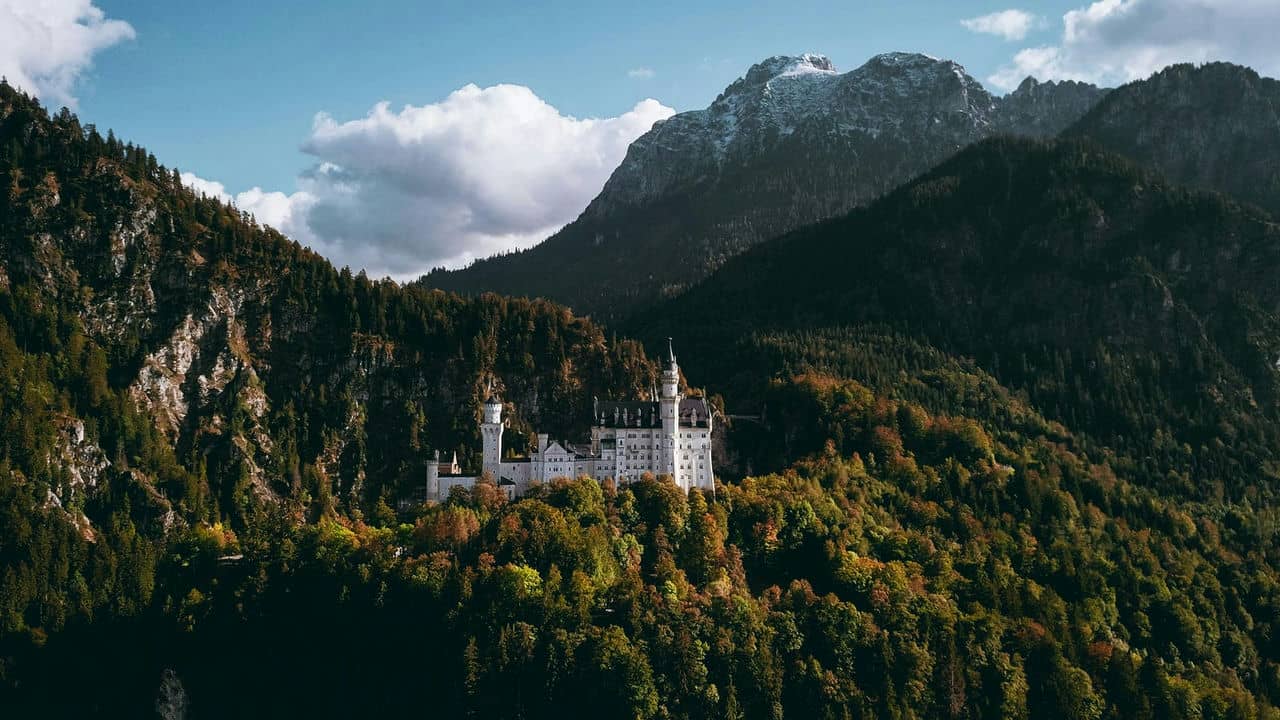
Are there any specific tours for architects or architecture enthusiasts visiting the Neuschwanstein Castle?
No, there are no special tours for architects or architecture enthusiasts visiting Neuschwanstein Castle. The standard 30-minute guided tours provide an overview of the history, design, and decoration but do not go into architectural details. However, those interested in the castle’s construction can still gain insight in a few ways. Firstly, one can book a private tour for a small group. Private guides may incorporate more discussion of the structural design, building techniques, or challenges faced during construction if asked. Secondly, while regular tours do not provide access, one can view exterior architectural details more closely by exploring the grounds independently before or after a tour. Lastly, a few spaces cover Neuschwanstein’s history that architects may find interesting, including a room with architectural drawings and models illustrating King Ludwig II’s vision and another with computer models showing the unfinished sections.
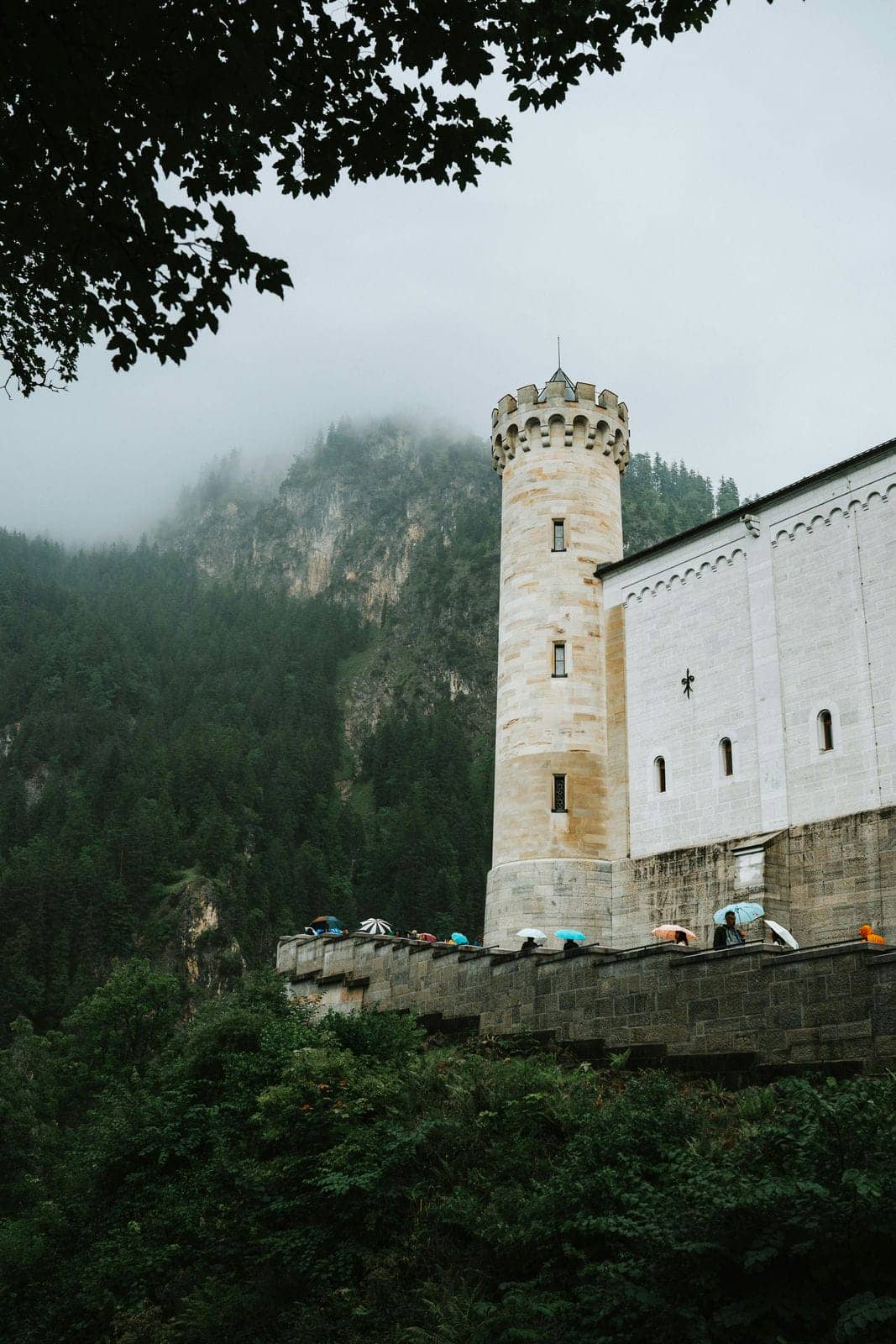
What lessons can architects learn from the design and construction of the Neuschwanstein Castle?
Architects can learn several key lessons from the design and construction of Neuschwanstein Castle. Firstly, architects should carefully balance client wishes, functionality, and context when designing buildings. King Ludwig II wanted the castle built purely to realize his romantic medieval fantasies. Architects must balance a client’s dreams, practical needs, and design sensitivity. Secondly, advances in engineering and technology can be integrated tastefully, even in historical revival styles. Neuschwanstein had modern heating, plumbing, communications, and structural systems despite its Gothic appearance. Lastly, extensive ornamentation places a restoration burden on future generations. Neuschwanstein’s limestone facades and intricate interiors require extensive ongoing conservation work. Architects should consider long-term maintenance impacts, carefully detailing embellished buildings to simplify upkeep while avoiding bland minimalism. Neuschwanstein Castle reveals lessons about reconciling fantasy and function, updating historical styles, and creating richly detailed yet durable structures.
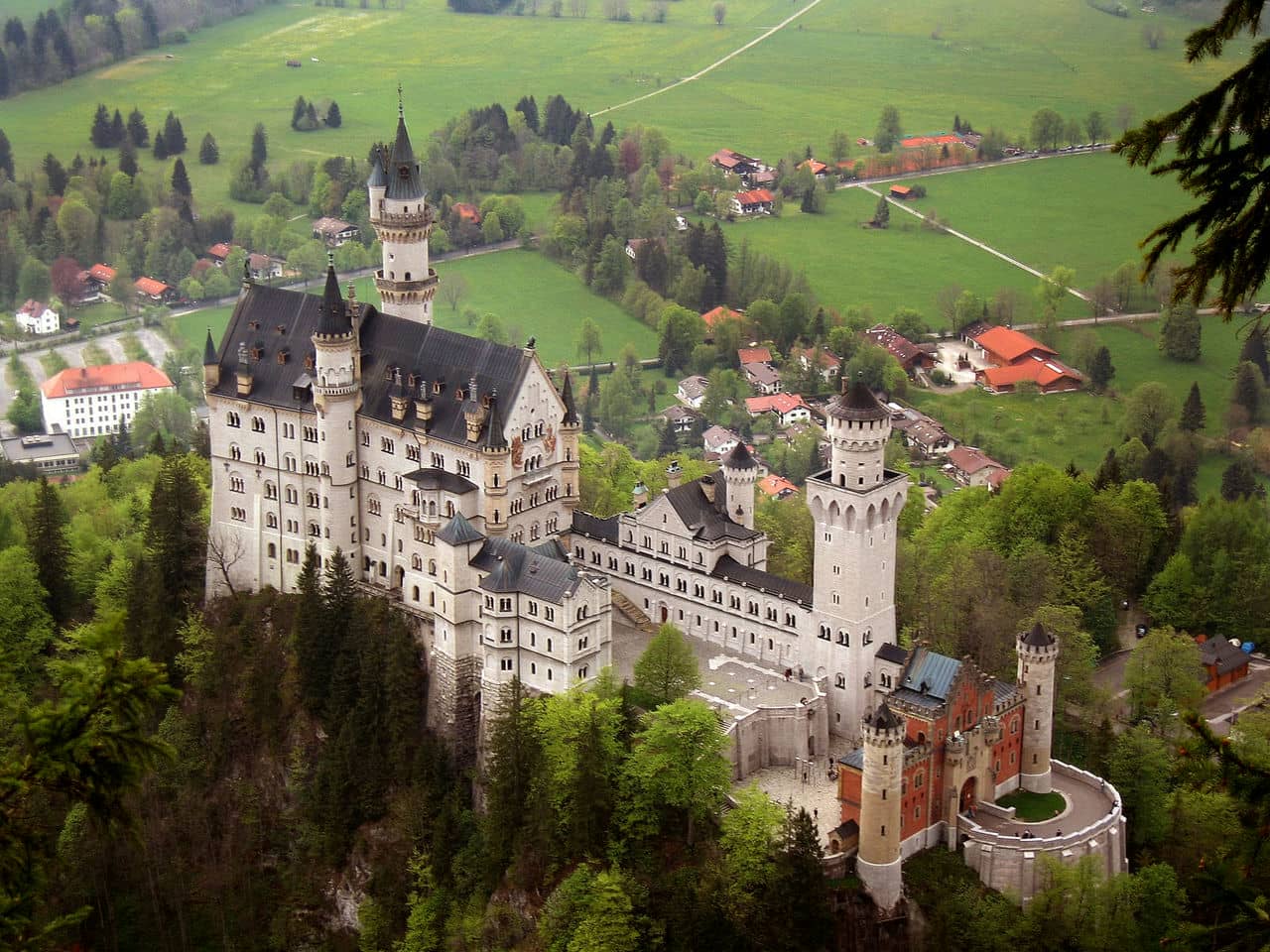
What are the best architectural landmarks in Germany to visit as an architect?
Listed below are the best architectural landmarks in Germany to visit as an architect:
- Brandenburg Gate, Berlin: Brandenburg Gate is a must-visit for architects interested in neoclassical architecture. Designed by Carl Gotthard Langhans and completed in 1791, it symbolizes both the turbulent history and reunification of Germany. The gate’s design is inspired by the Propylaea, the gateway to the Acropolis in Athens, exemplifying the influence of ancient Greek architecture on European neoclassicism. Its Doric columns, reliefs, and quadriga atop the gate offer a deep insight into the architectural artistry of the period.
- Neuschwanstein Castle, Bavaria: Neuschwanstein Castle is a seminal example of 19th-century Romantic architecture, making it an essential visit for architects studying this style. Commissioned by King Ludwig II of Bavaria and opened in 1886, the castle’s design was influenced by medieval and Byzantine architectural traditions, yet it also incorporated modern technology of the time. Its appearance has made it an inspiration for many modern-day storybook castles around the world.
- Bauhaus Dessau, Dessau: The Bauhaus Dessau building, designed by Walter Gropius and completed in 1926, is a pivotal site for architects exploring the Bauhaus movement and modernist architecture. The building’s functional design, featuring a glass curtain wall, flat roof, and an emphasis on geometric forms, embodies the Bauhaus principles of functionalism and simplicity. It serves as a physical manifesto of the movement’s ideas, combining art, craftsmanship, and technology in a cohesive architectural form.
- Cologne Cathedral, Cologne: Cologne Cathedral is a prime example of Gothic architecture, essential for architects interested in medieval building techniques and Gothic design. Construction began in 1248 and was completed in 1880, making it one of the largest cathedrals in Europe. The cathedral’s intricate stonework, flying buttresses, and twin spires dominate Cologne’s skyline, offering an in-depth look at the engineering marvels of Gothic architecture.
- Reichstag Building, Berlin: The Reichstag Building is a key site for architects studying the blend of historical and modern architecture. The original building, completed in 1894, has undergone several transformations, most notably the addition of the glass dome designed by Norman Foster in 1999. This modern addition symbolizes transparency and democracy, offering a view of the city and the parliamentary area below. The Reichstag stands as an example of how modern architecture can coexist with and enhance historic structures.
- Elbphilharmonie, Hamburg: The Elbphilharmonie in Hamburg, designed by Herzog & de Meuron and completed in 2017, is an example of modern architectural innovation and acoustical engineering. The building combines a traditional brick warehouse with a striking glass structure resembling waves, reflecting Hamburg’s maritime heritage. Its complex geometric forms and the world-class acoustics of its concert hall make it a landmark in contemporary cultural architecture. The building’s public plaza offers panoramic views of the city and the harbor, integrating the structure into its urban context.


